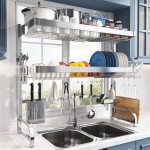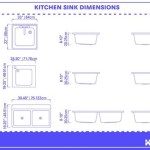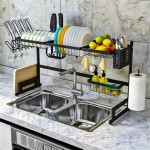Standard Kitchen Double Sink Size: A Comprehensive Guide
The kitchen sink serves as a critical workspace in any home, handling washing, rinsing, and food preparation tasks. The choice of a kitchen sink requires careful consideration of size, configuration, and material. Among the various options available, the double bowl sink remains a popular choice, offering flexibility and convenience. Understanding the standard dimensions of a double kitchen sink is essential for planning a kitchen renovation or new construction project.
This article will delve into the standard sizes of double kitchen sinks, exploring the different configurations, factors influencing size selection, and potential benefits and drawbacks associated with this sink type. This comprehensive guide aims to provide homeowners and design professionals with the necessary information to make informed decisions when selecting a double kitchen sink that meets their specific needs and preferences.
Understanding Standard Double Sink Dimensions
The term "standard" in relation to kitchen sink sizes can be somewhat misleading, as there is no single universally accepted dimension. However, certain size ranges are more commonly encountered than others. These ranges have evolved based on typical cabinet sizes, plumbing configurations, and ergonomic considerations.
Generally, a standard double kitchen sink falls within the following overall dimension ranges:
- Width (Front to Back): 16 to 22 inches
- Length (Side to Side): 22 to 48 inches
- Depth (Top to Bottom): 6 to 12 inches
The length of the sink, spanning from side to side, exhibits the greatest variability. Shorter double sinks, around 22 to 33 inches in length, are often found in smaller kitchens or apartments where space is limited. Larger double sinks, extending from 34 to 48 inches, are typically preferred in larger kitchens with ample countertop space. The width of the sink, from front to back, is less variable, as it is constrained by the standard depth of kitchen countertops, which is typically around 25 inches.
The depth of the sink, which indicates the distance from the top edge to the bottom, also plays a significant role in usability. Deeper sinks, ranging from 9 to 12 inches, offer more space for accommodating larger pots and pans. However, excessively deep sinks can cause strain on the back and arms, particularly for individuals of shorter stature. Shallower sinks, around 6 to 8 inches deep, may be more comfortable for some users but may not be as versatile for handling larger items.
It is crucial to remember that these are general guidelines and manufacturers may offer sinks with dimensions that deviate slightly from these ranges. Always consult the manufacturer's specifications for the precise dimensions of a particular sink model before making a purchase. These specifications will typically include not only the overall dimensions, but also the dimensions of each individual bowl, as well as the location and size of the drain openings.
Exploring Double Sink Configurations
Beyond the overall dimensions, the configuration of the two bowls within a double sink is another important factor to consider. Several common configurations are available, each offering distinct advantages.
Equal Double Bowl Sinks: This configuration features two bowls of equal size and depth. Equal bowls are suitable for tasks that require separation, such as washing dishes in one bowl and rinsing in the other. They offer a symmetrical appearance and are often preferred for their balanced aesthetic.
Unequal Double Bowl Sinks: As the name suggests, this configuration consists of two bowls of different sizes. Typically, one bowl is larger and deeper than the other. The larger bowl is suitable for washing bulky items, while the smaller bowl can be used for rinsing, food preparation, or drying dishes. Unequal double bowl sinks provide greater versatility and are well-suited for households with varying needs.
Low Divide Double Bowl Sinks: This configuration features a low divider between the two bowls, allowing for easier handling of large pots and pans that might not fit comfortably in a traditional double bowl sink. The low divide makes it possible to wash oversized items across both bowls without the obstruction of a high divider. These sinks are a good compromise for those who want the benefits of both a single bowl and a double bowl sink.
Offset Double Bowl Sinks: These sinks feature two bowls of equal or unequal size, but the bowls are offset to one side. This configuration can be useful in kitchens with limited space, as it allows for a more compact sink installation. The offset design also provides additional countertop space on one side of the sink.
The choice of double sink configuration depends on individual preferences, cooking habits, and the available space in the kitchen. Consider the types of tasks that will be performed most frequently at the sink and select a configuration that best accommodates those needs.
Factors Influencing Double Sink Size Selection
Selecting the appropriate size of a double kitchen sink involves considering several factors beyond the standard dimensions. These factors include the available cabinet space, the overall kitchen layout, the user's ergonomic needs, and personal preferences.
Cabinet Size: The sink must fit within the dimensions of the existing or planned sink base cabinet. Sink base cabinets are typically available in standard widths ranging from 30 to 48 inches. It is essential to select a sink that fits comfortably within the cabinet, allowing for adequate clearance for plumbing connections and ease of installation. A sink that is too large for the cabinet will require modifications, which can be costly and time-consuming. Always check the interior dimensions of the cabinet and compare them to the external dimensions of the sink before making a purchase.
Kitchen Layout: The overall layout of the kitchen also influences the choice of sink size. In smaller kitchens, a compact double sink or a single bowl sink may be more appropriate to maximize countertop space. In larger kitchens, a larger double sink can be accommodated without compromising functionality. Consider the proximity of other appliances, such as the dishwasher and refrigerator, when determining the optimal sink size. The sink should be conveniently located within the kitchen work triangle to minimize unnecessary movement and improve efficiency.
Ergonomic Considerations: The depth of the sink and the height of the countertop should be considered in relation to the user's height and reach. A sink that is too deep or a countertop that is too low can cause strain on the back and arms. Conversely, a sink that is too shallow or a countertop that is too high can also be uncomfortable to use for extended periods. Aim for a sink depth and countertop height that allows for comfortable and ergonomic use. Consider using a sink grid or basin rack to raise the bottom of the sink and reduce the reach required to access items.
Personal Preferences: Ultimately, the choice of double sink size is a matter of personal preference. Consider the types of tasks that will be performed most frequently at the sink and select a size that best accommodates those needs. Some individuals prefer a larger sink for washing oversized pots and pans, while others prefer a smaller sink for rinsing and food preparation. Visit showrooms and kitchen design centers to see different sink sizes and configurations in person and get a feel for what works best.
Before finalizing a purchase, create a template of the sink dimensions and place it on the countertop to visualize the actual space the sink will occupy. This will help in assessing the overall balance and functionality of the kitchen layout.
In conclusion, when selecting a standard double kitchen sink size, carefully considering the dimensions, bowl configuration, cabinet size, kitchen layout, ergonomic factors, and personal preferences is crucial. This approach ensures that the chosen sink provides optimal functionality, comfort, and aesthetic appeal within the kitchen environment.

E Ceramall Nirali Ecm Kitchen Sink Double Bowl Eceramall

Monic Sqm 830 Handmade Stainless Steel Double Bowl Kitchen Sink

Kwikot Inset Kitchen Sinks Prep Bowls Fabricated

Things To Consider Before Ing A Kitchen Sink

Dimension Of Kitchen Sink Standard Sizes In India Best S

Elkay Ec42105 Kitchen Sinks
What Are The Most Common Sink Sizes Vevano

American Standard Colony Pro Ada Drop In Stainless Steel 33 Double Bowl All One Kitchen Sink With Faucet 22db 6332283c 075 The Home

Kitchen Sink Double Bowl Topmount

Glasgow Double Bowl Farmhouse Sinks Bacera







